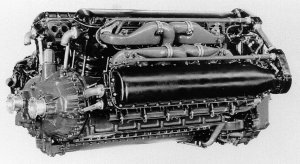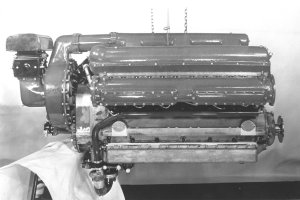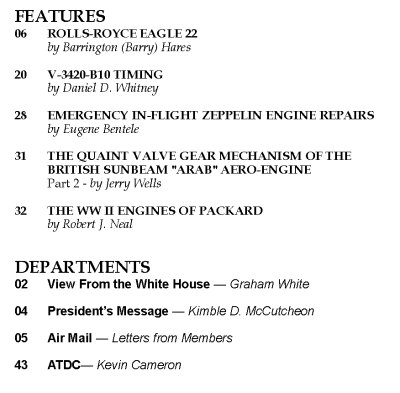
Torque Meter
Spring 2004 Issue
 |
|
Rolls-Royce Eagle 22 This 1/5th-scale Eagle 22 is a 24-cylinder, dual crankshaft, H-configuration, sleeve-valve, supercharged miniature engine as it stands in an almost completed state. Notice the sculptured nose sections. They are not castings, but are machined from the solid with a great amount of loving care to achieve that finish. While it is a near certainty that few will ever see inside a real Eagle 22, images of Barry Hares' model, in conjunction with his account of its gestation, provide a unique opportunity to better understand a truly spectacular aircraft engine. |
 |
V-3420-B10 Timing An interesting episode in the development of the Allison V-3420-B10 engine (which powered the Fisher P-75) was its initial inability to meet the contract guarantee for rated power and how it was resolved. Performance guarantees had been based on testing using an engine configured as a V-3420A to enable its running on the available Allison altitude test stand. So configured, the test engine used the standard V-3420A firing order with each of the 24 cylinders firing 30° apart. As designed and delivered the B-10 engine used 60° firing, i.e. simultaneous firing of two cylinders (one in each vee), referred to as "zero" phasing by Allison. When the engines were run in the altitude dynamometer it was found that the B-10 was about 3 percent low on power. In an effort to restore this power Allison adopted an alternate firing scheme known as 150° phasing and utilized a 30° interval. Historically, the details of how they accomplished this have been a mystery. Allison Competition Engines recently had an opportunity to teardown a B-10 known to have been modified with the 150° phasing. By taking careful notes of the as-found configuration we are now able to provide the details. |
 |
WWII Engines of Packard There has always been confusion among some engine historians regarding the design similarities, or lack of them, between the Packard PT (Patrol Torpedo) boat engines and the Packard-built Merlins of World War II. If we immediately cut to the basics, we can say that the only similarities are the fact that they are both 60° V-12 water-cooled engines. Neither is an evolution of the design of the other. Their only connection is the fact that both were built by Packard during World War II. This article briefly traces the origins of each and describe its design. |
